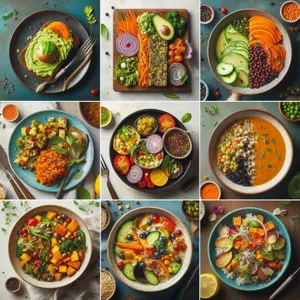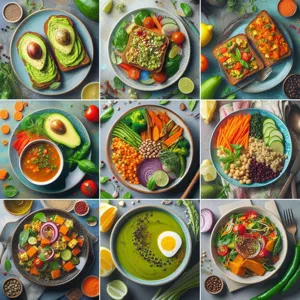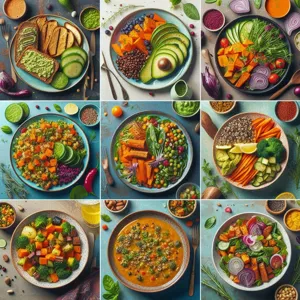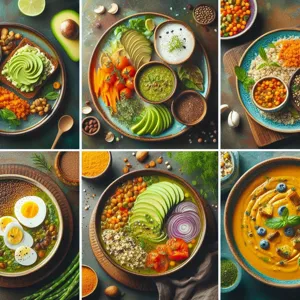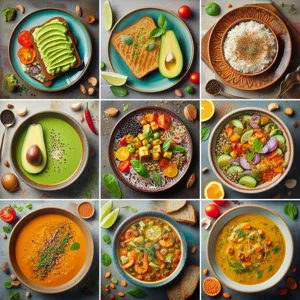In a world where dietary preferences and restrictions are increasingly common, gluten-free eating has emerged as a popular lifestyle choice for many, whether for health reasons, allergies, or simply as a personal preference.
The good news is that going gluten-free doesn’t mean sacrificing flavor or creativity in the kitchen. In fact, it opens the door to a wealth of delicious possibilities! From hearty breakfasts to decadent desserts, there’s a whole universe of gluten-free recipes just waiting to be explored. In this blog post, we’ll present the top 10 mouthwatering gluten-free recipes that are not only easy to prepare but also guaranteed to delight your taste buds. Whether you’re a seasoned gluten-free cook or just starting to explore this culinary path, these delightful dishes will inspire you to whip up meals that everyone—gluten-free or not—will love. Get ready to savor the flavors of wholesome ingredients and innovative cooking techniques that prove gluten-free can be utterly delicious!
1. Introduction to Gluten-Free Cooking
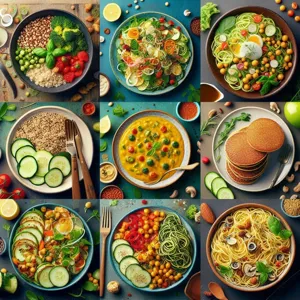
In recent years, gluten-free cooking has transcended dietary necessity, blossoming into a vibrant culinary movement that celebrates flavor, creativity, and inclusivity. Whether you’re navigating celiac disease, gluten sensitivity, or simply exploring the benefits of a gluten-free lifestyle, the world of gluten-free cooking offers a diverse array of ingredients and recipes that promise to tantalize your taste buds without sacrificing texture or satisfaction.
At its core, gluten-free cooking revolves around the art of substituting traditional grains with gluten-free alternatives. Imagine the warm, nutty aroma of quinoa, the delicate sweetness of almond flour, or the earthy richness of buckwheat. These ingredients serve as the foundation for dishes that are not only wholesome but also bursting with flavors and nutrients. Gluten-free cooking encourages experimentation, allowing home chefs to explore new flavor profiles and cooking techniques while embracing a healthier lifestyle.
As we embark on this culinary journey, you’ll discover that gluten-free recipes can be just as indulgent and satisfying as their gluten-filled counterparts. From mouthwatering breakfasts to decadent desserts, the possibilities are endless. So, whether you’re a seasoned gluten-free enthusiast or just dipping your toes into this exciting world, get ready to elevate your kitchen game with our top 10 must-try gluten-free recipes. Let’s dive into a delicious adventure that proves gluten-free cooking is anything but bland!
2. Benefits of a Gluten-Free Diet
Adopting a gluten-free diet can offer a myriad of benefits beyond just avoiding gluten-containing foods. For individuals with celiac disease or gluten sensitivity, eliminating gluten is essential to maintain health and well-being. However, even those without diagnosed conditions may find that a gluten-free lifestyle can lead to positive changes in their overall health.
One of the most notable benefits is improved digestive health. Many people report reduced bloating, gas, and discomfort after cutting gluten from their diets. This can lead to a more pleasant eating experience and heightened energy levels throughout the day. Additionally, a gluten-free diet often encourages individuals to incorporate a wider variety of whole foods, such as fruits, vegetables, lean proteins, and gluten-free grains like quinoa and brown rice. This shift can contribute to a more balanced and nutrient-rich diet.
Moreover, a gluten-free diet can enhance mental clarity and focus. Some individuals notice improvements in mood and cognitive function once they eliminate gluten, attributing this change to reduced inflammation in the body. For those who previously experienced brain fog, this newfound mental sharpness can be a game changer.
Another significant advantage is the potential for weight management. By removing processed gluten-laden foods, many people naturally gravitate toward healthier options, leading to better portion control and an overall reduction in calorie intake. This, combined with increased awareness of food choices, can facilitate a healthier lifestyle.
Lastly, embracing a gluten-free diet can foster creativity in the kitchen. With an abundance of gluten-free flours and alternative ingredients available, home cooks can experiment with new flavors and textures, resulting in delicious meals that even gluten-eaters will love. Overall, the benefits of a gluten-free diet extend far beyond dietary restrictions, paving the way for a healthier, more vibrant lifestyle.
3. Essential Ingredients for Gluten-Free Baking
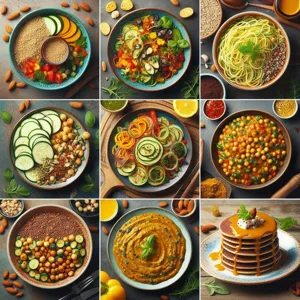
When embarking on your gluten-free baking journey, having the right ingredients is key to achieving that perfect texture and flavor that can often be a challenge without traditional flour. Here’s a rundown of essential ingredients that will transform your gluten-free baking experience from ordinary to extraordinary.
**1. Gluten-Free Flours:**
The foundation of any gluten-free recipe is, of course, the flour. A blend of gluten-free flours can yield the best results. Consider using almond flour for a nutty flavor and moist texture, or coconut flour for its lightness and fiber content. Other popular choices include brown rice flour, sorghum flour, and oat flour (ensure it’s certified gluten-free). Each type brings its unique characteristics, so don’t hesitate to experiment and find your favorite combinations!
**2. Starches:**
Incorporating starches like tapioca starch, potato starch, or cornstarch can help mimic the elasticity that gluten provides. These ingredients are pivotal in giving your baked goods a light and airy quality, making them rise beautifully. They also help bind the ingredients together, preventing crumbliness.
**3. Binding Agents:**
Without gluten, your baked goods need something to hold them together. Enter binding agents! Eggs are the most common choice, providing moisture and structure. If you’re looking for vegan options, consider flaxseed meal mixed with water or chia seeds, which create a gel-like consistency that works wonders in holding ingredients together.
**4. Sweeteners:**
While sugar is a staple in baking, experimenting with alternative sweeteners can enhance your gluten-free treats. Honey, maple syrup, and agave nectar can add depth of flavor and moisture, while also providing a natural sweetness. Don’t forget to account for the liquid content these add to your recipes!
**5. Flavor Enhancers:**
To elevate your gluten-free baked goods, consider adding flavor enhancers such as vanilla extract, cocoa powder, or spices like cinnamon and nutmeg. These ingredients can turn a simple recipe into a delightful masterpiece, ensuring your treats are as delicious as they are gluten-free.
**6. Dairy Alternatives:**
If you’re sensitive to lactose or following a dairy-free lifestyle, there are plenty of alternatives available. Almond milk, coconut milk, and cashew milk can seamlessly replace traditional milk without compromising flavor or texture. Similarly, dairy-free yogurts and creams can add richness to your recipes.
With these essential ingredients in your pantry, you’re well-equipped to create an array of gluten-free delights that everyone will love. Whether you’re baking soft cookies, fluffy cakes, or crusty breads, these components are your ticket to achieving deliciously satisfying results. So roll up your sleeves, grab your apron, and let the gluten-free baking adventures begin!
4. Recipe 1: Classic Gluten-Free Pancakes
There’s nothing quite like the smell of freshly cooked pancakes wafting through the kitchen on a lazy weekend morning. With this classic gluten-free pancake recipe, you can indulge in all the fluffy goodness without the worry of gluten. These pancakes are not only easy to make but also incredibly delicious, making them a perfect breakfast staple for everyone—gluten-free or not!
**Ingredients:**
– 1 cup gluten-free all-purpose flour blend
– 2 tablespoons sugar (or your preferred sweetener)
– 1 tablespoon baking powder
– 1/4 teaspoon salt
– 1 cup milk (dairy or non-dairy alternatives work beautifully)
– 1 large egg
– 2 tablespoons melted butter or coconut oil
– 1 teaspoon vanilla extract
**Instructions:**
1. **Mix the Dry Ingredients:** In a large bowl, whisk together the gluten-free flour, sugar, baking powder, and salt until well combined. This blend is the foundation for your light and fluffy pancakes.
2. **Combine the Wet Ingredients:** In a separate bowl, whisk together the milk, egg, melted butter (or coconut oil), and vanilla extract. The warm melted butter will create a lovely rich flavor, while the vanilla adds a touch of sweetness.
3. **Combine Wet and Dry:** Pour the wet ingredients into the dry ingredients, stirring gently until just combined. Be careful not to overmix; a few lumps are perfectly fine. Let the batter sit for a few minutes while you heat your skillet.
4. **Cook the Pancakes:** Heat a non-stick skillet or griddle over medium heat and lightly grease it with butter or oil. Pour about 1/4 cup of batter onto the skillet for each pancake. Cook until bubbles form on the surface and the edges look set, about 2-3 minutes. Flip and cook for another 1-2 minutes on the other side until golden brown.
5. **Serve and Enjoy:** Stack your pancakes high and serve them warm with your favorite toppings—fresh berries, maple syrup, a dollop of yogurt, or a sprinkle of powdered sugar.
These classic gluten-free pancakes are not only mouthwatering but also incredibly versatile. You can add chocolate chips, nuts, or even banana slices into the batter for a delightful twist. Whether you’re preparing a Sunday brunch or a quick weekday breakfast, these pancakes are sure to become a family favorite. Enjoy every fluffy bite, knowing you’re indulging in a delightful treat that everyone can savor!
5. Recipe 2: Zucchini Noodles with Pesto

Zucchini noodles, or “zoodles” as they’re affectionately known, are a fantastic gluten-free alternative that brings a refreshing twist to your pasta dishes. This recipe for Zucchini Noodles with Pesto not only tantalizes the taste buds but also offers a vibrant, health-conscious option that’s perfect for any meal.
To start, you’ll need a spiralizer or a simple vegetable peeler to transform fresh zucchini into long, delicate strands. As you spiralize, you’ll marvel at the way the bright green zucchini transforms into a beautiful nest of noodles, ready to soak up the flavors of the accompanying pesto.
The pesto itself is a burst of flavor, made from fresh basil, garlic, pine nuts, Parmesan cheese, and a drizzle of olive oil. Simply blitz all the ingredients in a food processor until smooth, and you’ll have a creamy, aromatic sauce that dances on the palate. The nutty richness of the pine nuts complements the herbal brightness of the basil, creating a harmonious blend that elevates the dish.
Once your zoodles are prepared, sauté them lightly in a pan with a splash of olive oil until they’re just tender—this takes only a few minutes, ensuring they retain a delightful crunch. Then, toss them with the freshly made pesto until every strand is coated in the vibrant green sauce. The result is a dish that not only looks stunning but also bursts with fresh flavors and textures.
Serve your Zucchini Noodles with Pesto warm, topped with a sprinkle of extra Parmesan and a few pine nuts for added crunch. This dish is not only gluten-free—it’s also a low-carb delight that satisfies cravings without weighing you down. Perfect for a quick weeknight dinner or a fancy gathering, this recipe is bound to become a staple in your kitchen. So grab those zucchinis, and let’s get cooking!
6. Recipe 3: Quinoa Salad with Roasted Vegetables
Elevate your meal prep with this vibrant Quinoa Salad with Roasted Vegetables, a dish that marries nutrition with flavor in every bite. Quinoa, a protein-packed superfood, serves as the perfect base, providing a nutty taste and fluffy texture that pairs beautifully with the colorful medley of roasted vegetables.
To create this delightful salad, start by preheating your oven to 400°F (200°C). Chop a mix of your favorite seasonal vegetables—think bell peppers, zucchini, and red onions—into bite-sized pieces. Toss them generously with olive oil, a sprinkle of salt, and a dash of your favorite herbs, such as thyme or rosemary, to enhance their natural sweetness. Spread the vegetables on a baking sheet and roast them for about 25-30 minutes, or until they’re tender and slightly caramelized.
While the vegetables are roasting, rinse one cup of quinoa under cold water to remove its natural coating, known as saponin, which can impart a bitter taste. Cook the quinoa in a pot with two cups of vegetable broth or water, bringing it to a boil, then reducing the heat and letting it simmer for about 15 minutes until the grains have absorbed all the liquid and are fluffy.
Once the quinoa and roasted vegetables are ready, combine them in a large bowl, adding a handful of fresh spinach or arugula for an extra pop of color and crunch. For an added layer of flavor, drizzle with a simple lemon vinaigrette made from fresh lemon juice, olive oil, a touch of Dijon mustard, and a pinch of salt and pepper. Toss everything together, and watch as the colors come alive.
This Quinoa Salad with Roasted Vegetables is not just a feast for the eyes; it’s a versatile dish that can be served warm or cold, making it perfect for meal prep, a light lunch, or as a stunning side dish for your next gathering. Packed with nutrients and bursting with flavors, it’s a gluten-free recipe that everyone—whether gluten intolerant or not—will love. Don’t be surprised when this salad becomes a staple in your kitchen!
7. Recipe 4: Gluten-Free Chocolate Chip Cookies

When it comes to comfort food, few treats can rival the classic chocolate chip cookie. This gluten-free version brings all the nostalgia of the original while accommodating those with dietary restrictions. Imagine biting into a warm cookie, the chocolate chips melting in your mouth, and the buttery flavor dancing on your taste buds—pure bliss!
To start, you’ll need a blend of gluten-free flours, such as almond flour and coconut flour, which not only keep the cookies soft and chewy but also add a delightful nuttiness. The magic begins when you cream together the butter and sugars, allowing the sweet aroma to fill your kitchen. A touch of vanilla extract enhances the flavor, while a pinch of salt balances the sweetness beautifully.
As you fold in the gluten-free chocolate chips, you’ll be tempted to sneak a taste of the dough—resist the urge, even though it’s incredibly tempting! Once the dough is ready, scoop generous portions onto a baking sheet, leaving room for the cookies to spread out and create that perfectly crisp edge.
Bake until golden brown, and let them cool for a few minutes before transferring to a wire rack. The first bite will reveal a crunchy exterior giving way to a soft, gooey center filled with melted chocolate. These gluten-free chocolate chip cookies are not just a substitute; they’re a delightful treat that stands on their own.
Serve them warm with a glass of cold milk or enjoy them as a midday snack. No one will ever guess they’re gluten-free, and you might just find these cookies becoming a new household favorite. Indulge in the joy of baking with this easy recipe, and watch as friends and family come back for seconds—because who can resist a freshly baked cookie?
8. Recipe 5: Stuffed Bell Peppers
Prepare to indulge in a vibrant explosion of flavors with our gluten-free stuffed bell peppers! This dish not only looks stunning on your dinner table but is also packed with nutrients, making it a wholesome choice for any meal.
Begin with fresh, colorful bell peppers—red, yellow, and green—with their glossy skins glistening under the kitchen light. Slice the tops off and carefully remove the seeds, creating the perfect vessel for a savory filling. The aroma of sautéed onions and garlic fills your kitchen as you cook them to a golden brown in a splash of olive oil.
Next, mix in cooked quinoa or rice (both of which are naturally gluten-free), along with black beans for protein, sweet corn for a touch of sweetness, and diced tomatoes for juiciness. season your filling with cumin, paprika, and a dash of chili powder to give it a zesty kick. Don’t forget to fold in a handful of fresh herbs like cilantro or parsley for an added burst of freshness.
Once your filling is ready, generously spoon it into each bell pepper, packing it tightly to ensure every bite is bursting with flavor. Top each pepper with a sprinkle of shredded cheese or a dairy-free alternative, if you prefer, to create a delightful, melty topping.
Arrange the stuffed peppers in a baking dish, add a splash of vegetable broth at the bottom to keep them moist, and bake in a preheated oven until the peppers are tender and the cheese is bubbly—about 25-30 minutes. The anticipation builds as the delicious aroma wafts through your home.
Serve these colorful creations warm, garnished with a dollop of sour cream or a drizzle of avocado cilantro sauce for an extra layer of creaminess. Not only are these stuffed bell peppers a feast for the eyes, but they also offer a satisfying and healthy meal that even those without dietary restrictions will love. Perfect for family dinners or as a crowd-pleaser at gatherings, this recipe is sure to become a staple in your gluten-free repertoire!
9. Recipe 6: Creamy Gluten-Free Mac and Cheese
Indulging in a comforting bowl of mac and cheese doesn’t have to be off-limits just because you’re avoiding gluten. This creamy gluten-free mac and cheese recipe is a game-changer, delivering all the gooey, cheesy goodness you crave without sacrificing flavor or texture.
To start, choose gluten-free pasta like brown rice or chickpea pasta; both options hold their shape beautifully and provide a satisfying bite. As the pasta cooks to al dente perfection, whisk together a rich cheese sauce that combines sharp cheddar, creamy mozzarella, and a hint of nutty parmesan. The key to achieving that ultra-creamy consistency is incorporating a blend of milk and a touch of cream; this mixture creates a luscious sauce that coats every noodle.
But why stop there? Elevate your mac and cheese by adding sautéed garlic, chopped spinach, or crispy bacon for an extra layer of flavor and texture. For those who enjoy a bit of heat, a sprinkle of cayenne pepper or a dash of hot sauce can take this classic dish to a new level of deliciousness.
Once everything is combined, transfer the mixture to a baking dish and top it off with gluten-free breadcrumbs or crushed gluten-free crackers for that perfect crunchy topping. Bake until bubbly and golden, and prepare for a mouthwatering experience that will have everyone asking for seconds.
Whether it’s a cozy family dinner or a potluck gathering, this creamy gluten-free mac and cheese is sure to be a hit. With its rich flavors and comforting texture, it proves that gluten-free cooking doesn’t mean compromising on taste. So grab your forks and dig into this delightful dish that promises satisfaction in every bite!
10. Recipe 7: Flourless Chocolate Cake
When it comes to indulgent desserts, the Flourless Chocolate Cake reigns supreme, especially for those following a gluten-free lifestyle. This rich and decadent treat is a chocolate lover’s dream, boasting a velvety texture that melts in your mouth. Made with just a handful of high-quality ingredients, it’s a simple yet elegant option that will impress both gluten-free and gluten-loving guests alike.
The magic begins with premium dark chocolate, which is gently melted with butter to create a luxurious base. The addition of eggs gives the cake its structure, while sugar adds the perfect touch of sweetness. A hint of vanilla enhances the chocolate flavor, and a pinch of salt elevates the overall taste profile, balancing the sweetness beautifully.
What truly sets this cake apart is its ease of preparation. Simply combine your ingredients in a bowl, pour the luscious batter into a greased cake pan, and bake until it’s set but still slightly gooey in the center. The result is a cake that is not only gluten-free but also deeply satisfying, with a rich, fudgy interior and a slightly crisp exterior.
For an extra touch, dust the top with powdered sugar or cocoa powder before serving, and consider pairing it with a dollop of freshly whipped cream or a scoop of vanilla ice cream for a delightful contrast. This Flourless Chocolate Cake is perfect for special occasions or as a decadent treat any day of the week. Once you’ve tasted this heavenly dessert, you’ll find it hard to believe that something so rich and delicious can be made without flour!
11. Recipe 8: Gluten-Free Breakfast Muffins
Start your day on a delicious note with these incredibly moist and fluffy gluten-free breakfast muffins that are perfect for busy mornings or leisurely brunches. These muffins are not only gluten-free but also packed with wholesome ingredients that will keep you fueled throughout the day.
Imagine biting into a warm muffin, the golden-brown exterior giving way to a tender, airy crumb scented with hints of vanilla and cinnamon. Each muffin is a delightful explosion of flavor, with juicy blueberries or ripe bananas providing natural sweetness and added nutrition. The best part? They are incredibly easy to make, requiring just a few simple steps.
To create these breakfast delights, you’ll need a blend of gluten-free flour—such as almond or oat flour—which lends a nutty richness and light texture. Combined with a pinch of baking powder and soda, these muffins rise beautifully in the oven. Add in some Greek yogurt for a protein boost and an extra moist crumb, and you’ve got a base that’s both satisfying and nutritious.
Feel free to customize your muffins with your favorite add-ins—chocolate chips, nuts, or even a sprinkle of seeds for a delightful crunch. Bake them in a preheated oven until they’re golden and puffy, then let them cool just enough to avoid burning your tongue before diving in.
These gluten-free breakfast muffins are not just a treat for the taste buds; they also freeze wonderfully, allowing you to whip out a quick breakfast option whenever you need it. Whether enjoyed plain, slathered with a bit of almond butter, or paired with a cup of coffee, they are sure to become a staple in your gluten-free repertoire. So, preheat your oven, gather your ingredients, and treat yourself to a batch of these heavenly muffins that will have everyone begging for seconds!
12. Recipe 9: Savory Gluten-Free Pizza
Craving a slice of pizza without the gluten? Look no further than this Savory Gluten-Free Pizza recipe that is sure to satisfy your cheesy cravings while keeping your dietary needs in check! This delightful dish features a homemade gluten-free crust that perfectly balances crispiness and chewiness, providing the ideal foundation for your favorite toppings.
To create the crust, you’ll combine a blend of gluten-free flours—such as almond flour, brown rice flour, and tapioca starch—seasoning it with a sprinkle of garlic powder and Italian herbs for an aromatic kick. A touch of olive oil adds richness, while warm water brings everything together into a smooth dough that’s easy to work with.
Once your crust is prepped and baked to golden perfection, it’s time to unleash your creativity! Spread a generous layer of zesty marinara sauce across the surface, followed by a melty layer of mozzarella cheese. From there, the world is your oyster—top it with vibrant veggies like bell peppers, mushrooms, and red onions, or add protein-packed options such as pepperoni or grilled chicken. For an extra flavor boost, consider a drizzle of pesto or a sprinkle of red pepper flakes.
Bake your masterpiece in a preheated oven until the cheese is bubbly and the edges are beautifully crisp. The result? A savory gluten-free pizza that not only looks mouthwatering but tastes absolutely divine. Whether you’re hosting a casual dinner or just indulging in a treat for yourself, this recipe is bound to become a go-to favorite in your kitchen. Enjoy every cheesy, gluten-free bite!
13. Recipe 10: Easy Gluten-Free Tacos
Tacos are a beloved staple in many households, and the great news is that you can easily make them gluten-free without sacrificing any of the flavor that makes them so irresistible. These Easy Gluten-Free Tacos are not only quick to prepare but also customizable to suit your taste buds, making them the perfect weeknight meal or a fun addition to your next gathering.
**Ingredients:**
To start, gather your favorite taco fillings. For the base, you can use corn tortillas, which are naturally gluten-free and add a delightful corn flavor. Choose from a variety of proteins such as seasoned ground beef, shredded chicken, or black beans for a vegetarian option. Don’t forget to load up on fresh toppings like diced tomatoes, shredded lettuce, avocado slices, and a sprinkle of cheese. For a kick, consider adding jalapeños or a zesty salsa.
**Instructions:**
1. **Prepare the Protein:** In a skillet, brown your chosen protein over medium heat, adding taco seasoning (ensuring it’s gluten-free) and a splash of water. Stir until well combined and heated through.
2. **Warm the Tortillas:** While the protein is cooking, warm your corn tortillas in another skillet over low heat for about 30 seconds on each side until they are pliable and slightly charred.
3. **Assemble Your Tacos:** Layer the tortillas with a generous scoop of your protein, followed by your choice of toppings. Get creative! Add a dollop of sour cream or a drizzle of lime juice to enhance the flavors.
4. **Serve and Enjoy:** Arrange your tacos on a platter and serve them immediately, allowing everyone to build their own masterpiece.
**Why You’ll Love Them:**
These Easy Gluten-Free Tacos are not just simple; they are a canvas for creativity, allowing you to mix and match flavors and ingredients. The satisfying crunch of the corn tortillas paired with the savory filling and fresh toppings is bound to please any crowd. Plus, they are a fantastic way to introduce gluten-free eating to family and friends without them even noticing they’re missing out on gluten!
So, whether you’re preparing for Taco Tuesday or just need a quick and delicious meal, these tacos will quickly become a go-to recipe in your gluten-free arsenal. Enjoy every bite and watch as they disappear from the plate!
14. Tips for Cooking and Baking Gluten-Free
Cooking and baking gluten-free can feel like navigating a new culinary landscape, but with the right tips and tricks, you’ll find it’s a delicious adventure! Here are some essential guidelines to help you create mouthwatering gluten-free dishes that will satisfy everyone at the table, whether they have dietary restrictions or not.
**1. Choose the Right Flour:** Not all gluten-free flours are created equal. Familiarize yourself with a variety of gluten-free flours such as almond flour, coconut flour, brown rice flour, and chickpea flour. Each brings its unique flavor and texture to your recipes. A good tip is to blend different types of gluten-free flours to achieve the best results.
**2. Understand Gluten Substitutes:** When baking, gluten-free recipes often require additional binders to mimic the elasticity that gluten provides. Ingredients like xanthan gum or guar gum can help your baked goods hold together better. Typically, you’ll need about one teaspoon of xanthan gum per cup of gluten-free flour.
**3. Hydration is Key:** Gluten-free flours absorb more moisture than traditional wheat flour, so be prepared to adjust your liquid ingredients. You may find that adding a little extra water, milk, or eggs can make all the difference in achieving the perfect consistency.
**4. Don’t Skip the Resting Time:** Allowing your gluten-free dough or batter to rest for at least 30 minutes before baking can improve texture and flavor. This resting period allows the flours to fully hydrate and the flavors to meld, resulting in a more cohesive dish.
**5. Experiment with Flavorings:** Gluten-free cooking is the perfect opportunity to get creative with flavors. Add spices, herbs, citrus zest, or extracts to enhance your dishes. Ingredients like vanilla extract or citrus zest can elevate your baked goods, making them truly irresistible.
**6. Keep it Clean:** Always ensure your cooking utensils and surfaces are free of gluten contamination. If you’re cooking for someone with celiac disease or a severe gluten intolerance, consider designating specific tools and spaces for gluten-free cooking to prevent cross-contact.
**7. Taste as You Go:** Gluten-free recipes can sometimes differ in taste and texture from their gluten-filled counterparts. Don’t hesitate to taste your creations as you go along, adjusting seasonings and flavors until you achieve a perfect balance.
By following these tips, you’ll find that cooking and baking gluten-free can be both enjoyable and satisfying. With a little practice, you’ll be whipping up gluten-free dishes that are not just safe, but also scrumptious and memorable. So grab your apron and let the culinary creativity flow!
15. Conclusion: Embracing a Delicious Gluten-Free Lifestyle
As we wrap up our journey through these ten tantalizing gluten-free recipes, it’s clear that embracing a gluten-free lifestyle doesn’t mean sacrificing flavor or culinary delight. Instead, it opens up a world of creativity in the kitchen, where wholesome ingredients take center stage and every meal can be an exploration of taste and texture.
From hearty breakfast options that kick-start your day with energy to mouthwatering dinners that leave everyone at the table satisfied, each recipe serves as a reminder that gluten-free does not equate to flavor-free. The vibrant colors of fresh vegetables, the nutty undertones of gluten-free grains, and the sweet notes of naturally gluten-free desserts all come together to create dishes that are not just healthy, but also utterly delicious.
Moreover, the shift to a gluten-free diet can foster a deeper appreciation for the ingredients we choose. By exploring alternatives like almond flour, quinoa, and chickpea pasta, you may discover new favorites that will enrich your cooking repertoire. This journey is not just about dietary restrictions; it’s about embracing a lifestyle that prioritizes nourishment and well-being.
So whether you’re gluten-sensitive, have celiac disease, or simply wish to explore the bountiful benefits of gluten-free eating, these recipes are here to inspire you. Dive into the kitchen with confidence, experiment with flavors, and share your culinary creations with friends and family. Embrace this deliciously gluten-free lifestyle, and let every meal be a celebration of health, taste, and creativity!


